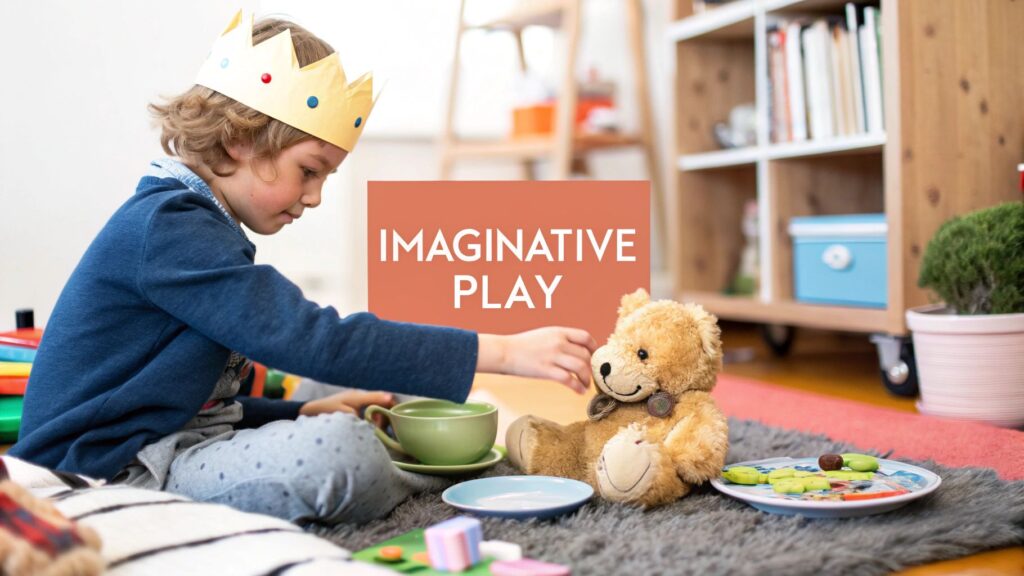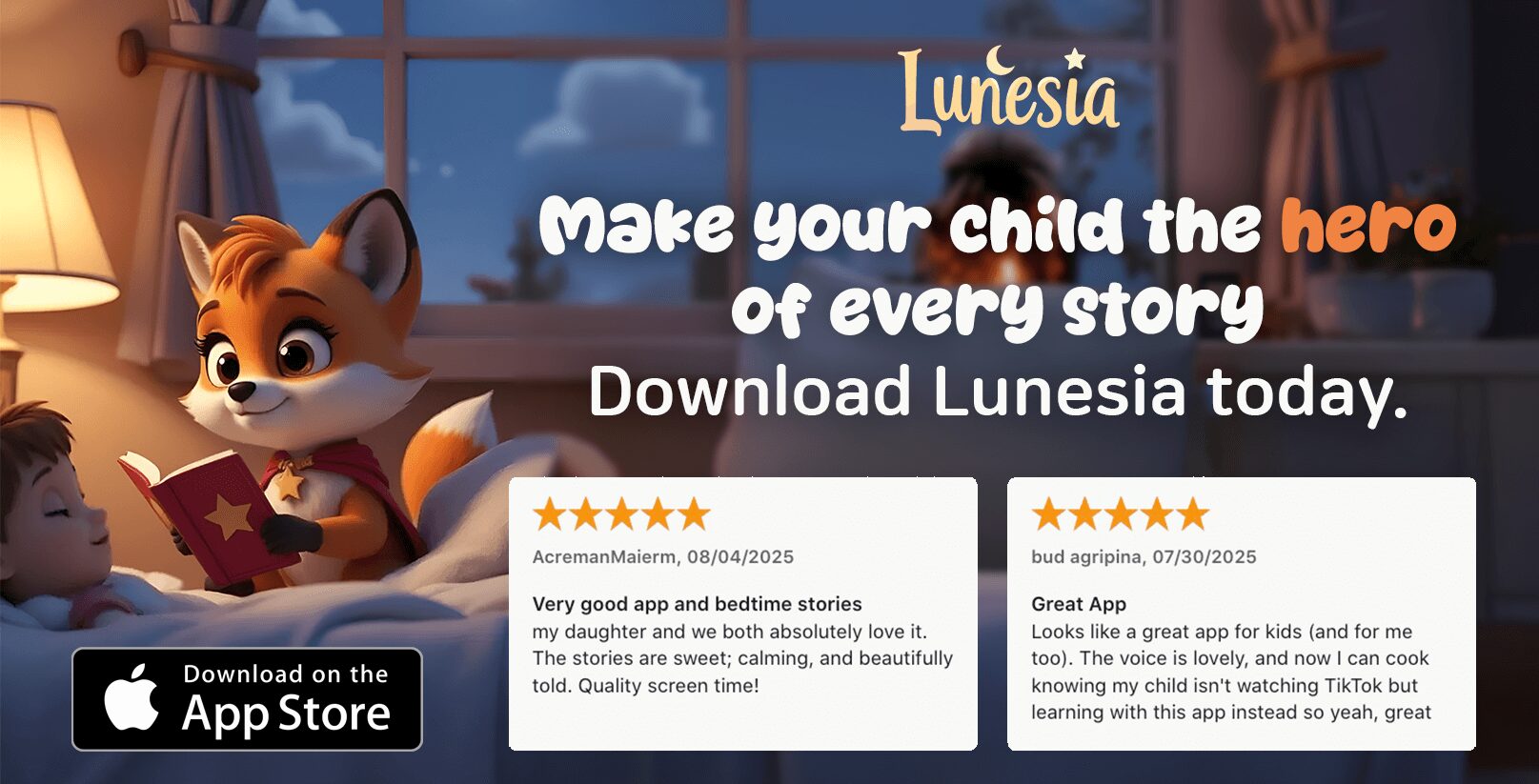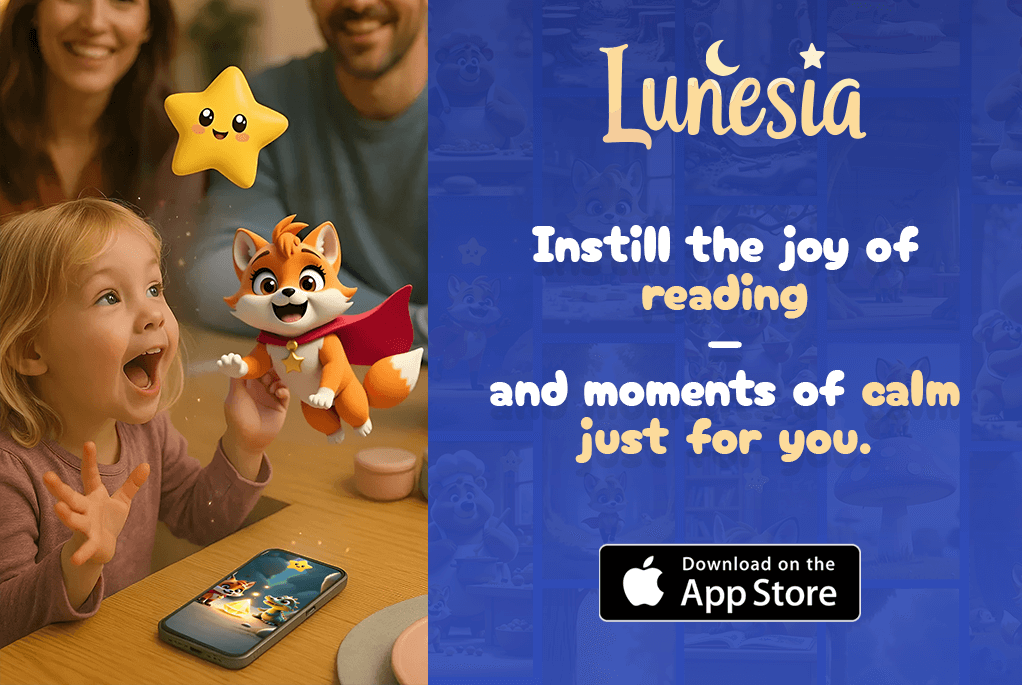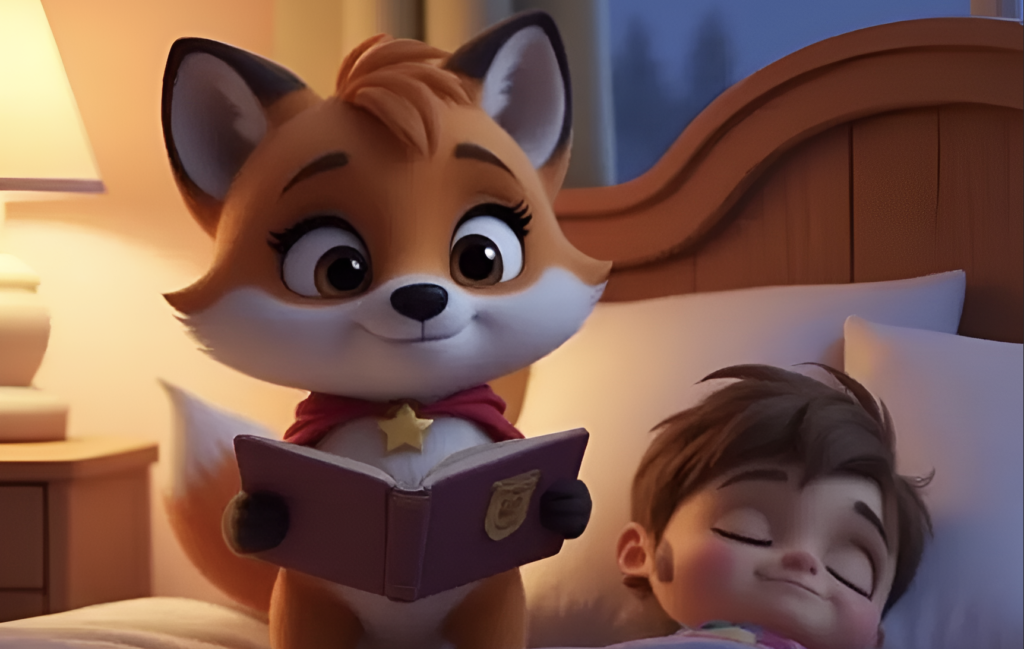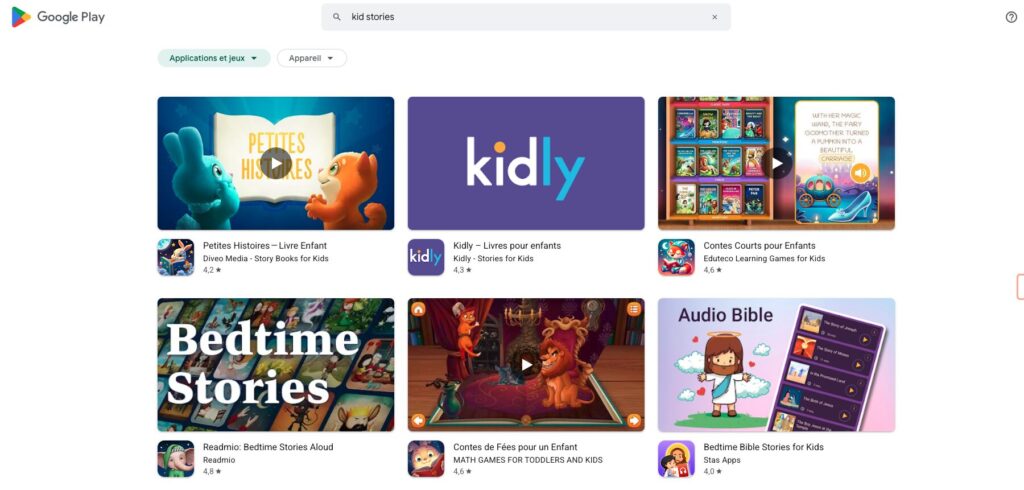Ever watch your child serve invisible tea to a row of stuffed bears and wonder what’s going on in that incredible little mind? That magical world they’ve created is imaginative play, and it’s one of the most powerful forces in their development.
It’s their first draft of life—a place where a cardboard box becomes a rocket ship and a blanket fort is a king’s castle. And for you, it's a golden opportunity to see the world through their eyes.
Unlocking Your Child’s Secret World of Play
When your five-year-old insists he’s a firefighter rescuing the family cat from a tree (that’s actually the couch), what’s really happening? Or when your toddler holds a banana to her ear and says, “Hello?” This isn’t just cute nonsense; it’s a brilliant developmental process in action.
So, what exactly is imaginative play? It's the beautiful, chaotic, and profound way children make sense of the world around them.
This type of play lets them step into different roles, experiment with social rules, and safely explore big, confusing emotions. It's the laboratory where they can test out courage, kindness, and problem-solving without any real-world consequences. Sometimes, the spark is as simple as imagining a fantastical world, maybe even by creating a fairy tale castle with crayons and paper.
From Simple Pretending to Complex Stories
Have you noticed how your child's play has changed over time? Imaginative play isn't a single skill but a journey that grows right alongside them. It often starts with simple symbolic actions—like pretending to sip from an empty cup—and blossoms into elaborate, cooperative adventures with friends.
This infographic gives a great snapshot of the typical stages kids move through as their creative minds expand.
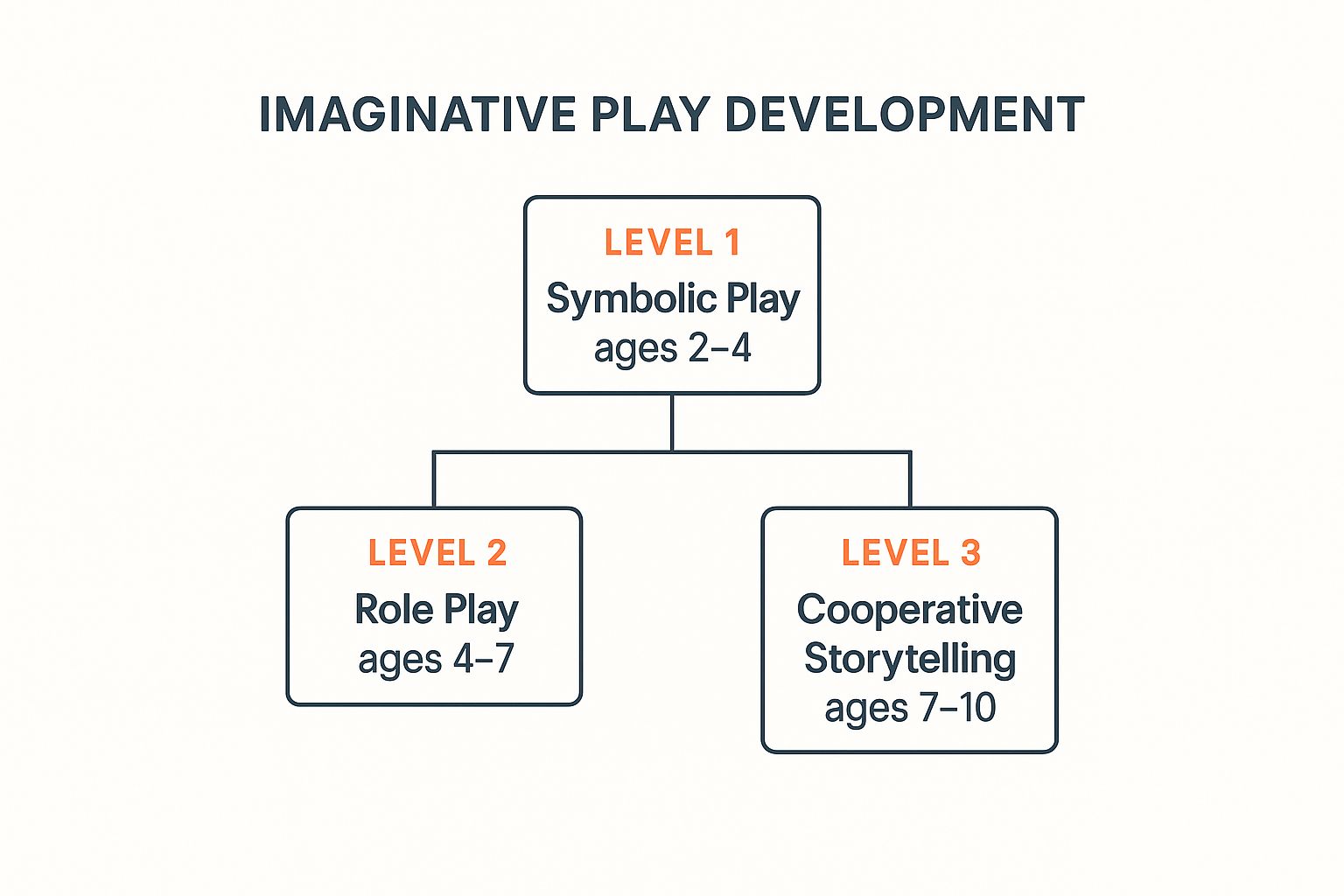
As you can see, what starts as basic make-believe evolves into complex role-playing and collaborative storytelling, laying the groundwork for some seriously advanced social skills.
To get a clearer picture, let's break down the core components that make imaginative play so powerful.
The Four Pillars of Imaginative Play
Think of imaginative play as a structure built on four key pillars. Each one supports a different area of your child's growth, from thinking symbolically to cooperating with others. Understanding these helps you see the "why" behind their whimsical games.
| Pillar of Play | What It Looks Like | What Your Child Is Learning |
|---|---|---|
| Symbolic Representation | Using a block as a phone or a stick as a magic wand. | Abstract Thinking: Understanding that one object can stand for another. |
| Role-Playing | Pretending to be a doctor, a chef, a superhero, or even the family dog. | Empathy & Social Skills: Stepping into someone else's shoes and seeing the world from a different perspective. |
| World-Building | Creating a detailed setting, like a "lava floor" in the living room or a fairy village in the garden. | Creativity & Planning: Organizing thoughts, setting rules, and bringing a vision to life. |
| Narrative Creation | Weaving a story with a beginning, middle, and end, even if it’s a simple one. | Language & Logic: Structuring events in a sequence and developing storytelling abilities. |
When you see these pillars in action, you're not just watching a game. You're witnessing the fundamental building blocks of creativity, empathy, and intelligence being put into place, one pretend adventure at a time.
The Power of Guided Adventures
This form of symbolic play is a cornerstone of early development, typically taking flight between the ages of 2 and 7. Did you know its benefits stick around for years, shaping how they learn and interact as they grow?
This is where you, as a parent, have a secret advantage. You can nurture this incredible growth not just with props and costumes, but with stories that ignite their imagination.
That’s where an app like Lunesia comes in. It offers a universe of interactive audio adventures where your child isn’t just a passive listener—they're the hero. They get to make choices that shape the story, learning about empathy and resilience in a safe, completely ad-free world. While they’re engrossed in a meaningful quest, you get a precious, guilt-free moment for yourself, confident they’re learning and growing. We dive much deeper into the power of stories in our guide to narrative play in early childhood.
The Developmental Superpowers of Pretend Play
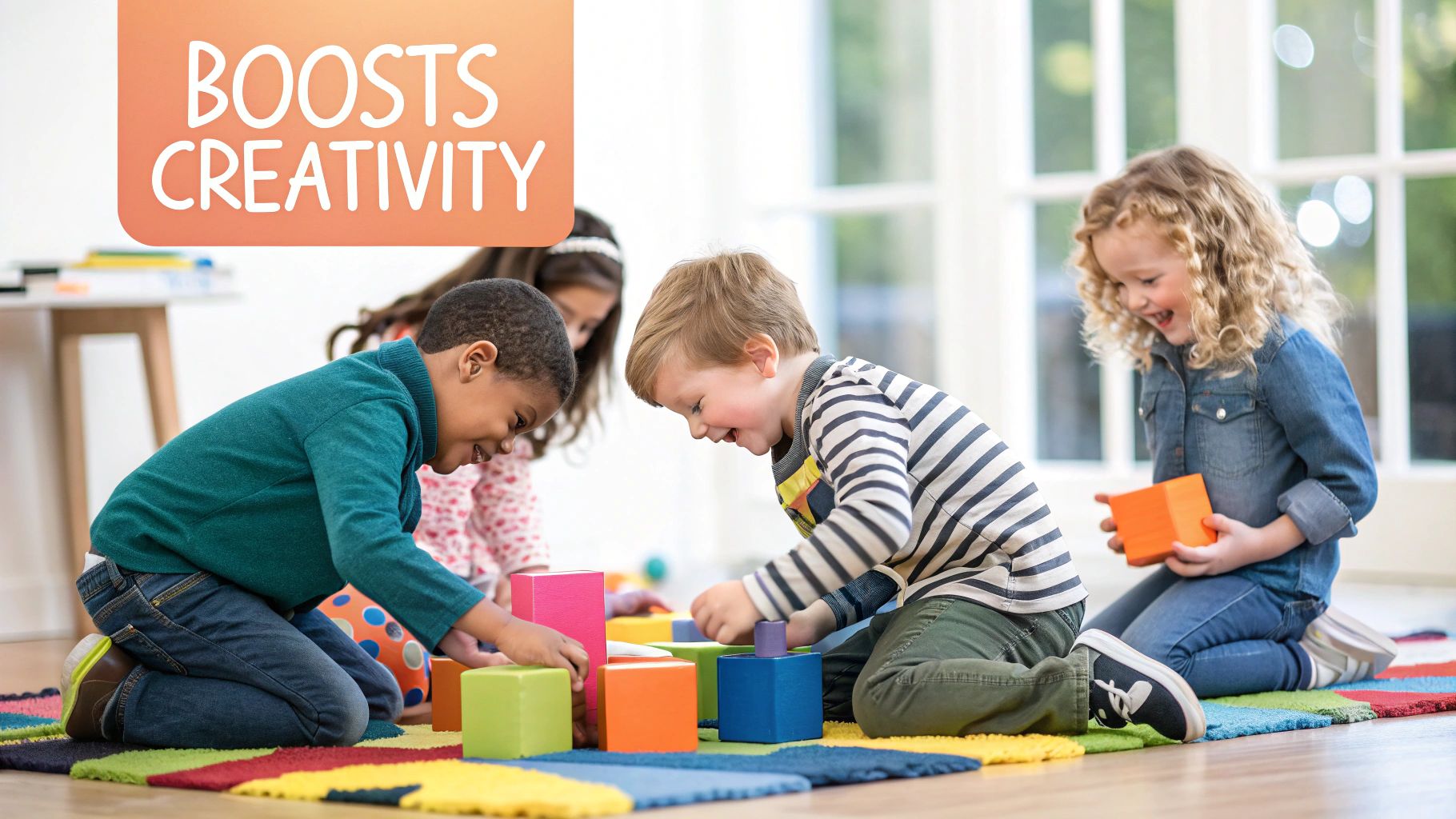
You might think that afternoon of make-believe is just a clever way to keep your child busy. But what if I told you it’s where their hidden magic comes from? Imaginative play is a true developmental powerhouse, quietly building the most essential skills your child will need for life. It's so much more than fun—it's the most important work of their childhood.
Think about it. When your child pretends to be a doctor caring for a sick teddy bear, they’re not just playing; they're practicing empathy. When they’re navigating a complex superhero rescue mission with friends, they’re sharpening their problem-solving and negotiation skills in real-time.
Building Emotional and Social Smarts
Ever wonder how to teach your child to handle disappointment or understand a friend's feelings? You don't always need a lecture; you just need to let them play. Imaginative play is the natural training ground for this exact challenge, giving them a safe space to explore complex social scenes and big emotions without real-world consequences.
For instance, when a game of "house" leads to a disagreement over who gets to be the parent, your child learns to manage frustration, communicate their needs, and find a compromise. This is where resilience is born.
These playful moments are emotional rehearsals. They equip children to handle everything from playground disagreements to their own anxieties, building a foundation of confidence and emotional intelligence.
And science backs this up. A 2020 study showed that preschoolers who regularly engage in fantasy play demonstrate better emotional regulation skills. This isn't just a nice-to-have; it's a critical life skill. You can explore more about these findings on how pretend play builds executive function.
Nurturing a Problem-Solving Mind
So, beyond social skills, what is imaginative play really doing for their brain? It’s teaching them to think flexibly and creatively. A simple blanket fort requires planning, engineering, and teamwork. Deciding how to rescue a toy from "quicksand"—also known as the living room rug—sparks critical thinking on the spot.
These scenarios teach children to:
- Think Symbolically: Grasping that a stick can be a magic wand is the first step toward abstract thought. This is the same skill they’ll need for math and science down the road.
- Create and Follow Rules: Even the most chaotic-looking games have an internal logic and rules that players agree on, which is a fantastic way to foster self-regulation.
- Develop Language Skills: Children use richer, more complex language during pretend play. It's a natural workout for their vocabulary and storytelling abilities. You can read more about how the power of play supports early learning in our detailed guide.
This is exactly where Lunesia can be a parent's best friend. Our interactive stories put children at the center of the adventure, asking them to make decisions that actually shape the outcome. They aren't just listening; they're actively solving problems, helping characters show courage, and learning kindness firsthand. While they're on a meaningful quest, you get a precious, guilt-free moment for yourself, knowing they’re in a safe, ad-free environment that’s building their brain.
Sparking Imagination with Simple Everyday Objects
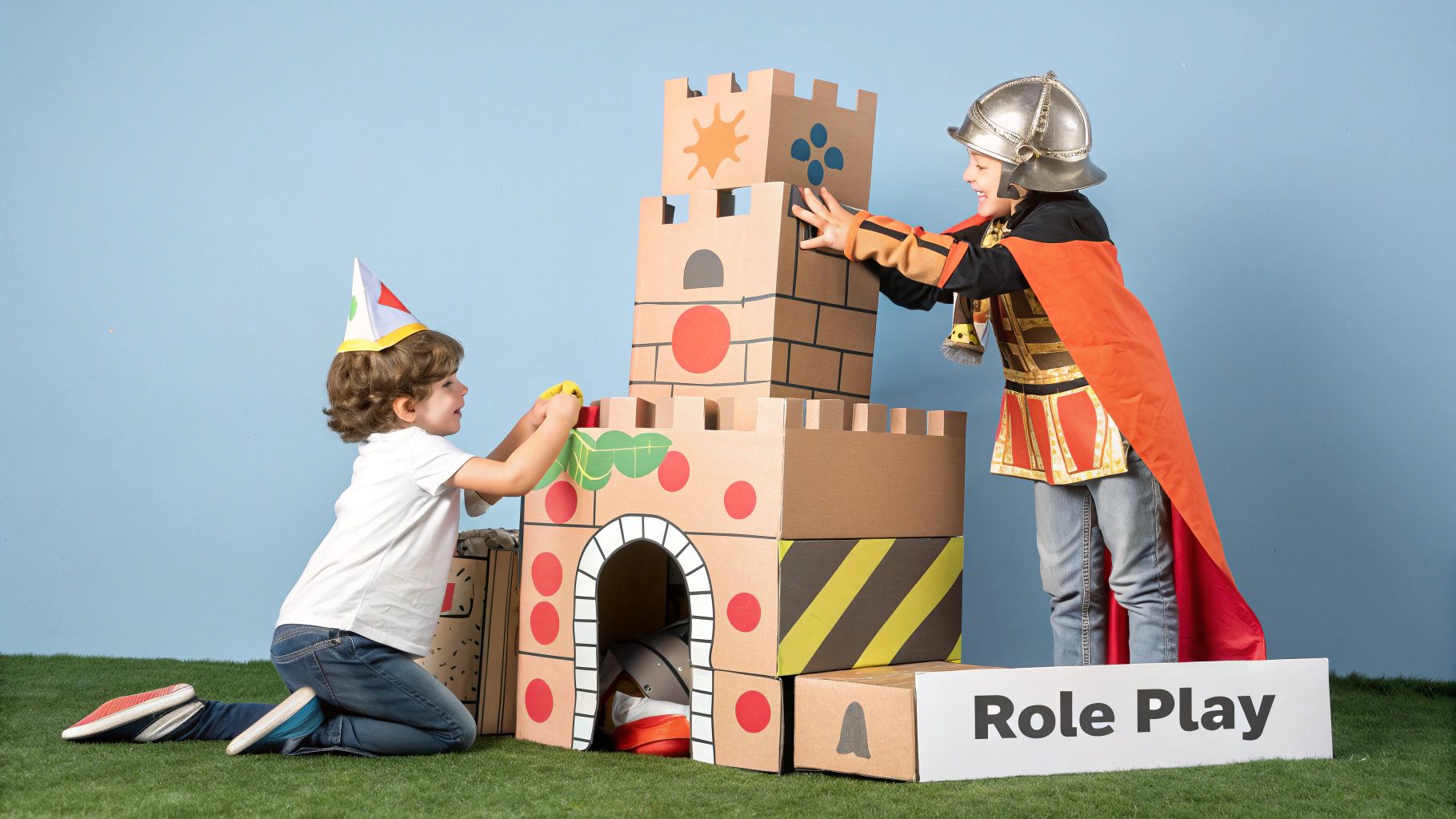
Here's a little secret that big toy companies might not want you to know: you don't need a house overflowing with expensive, battery-operated gadgets to spark your child's imagination. In fact, some of the very best tools for creative play are probably already hiding in your cupboards, closets, and recycling bin.
It’s a simple truth I've seen time and time again. The simpler the object, the more work your child's brain has to do—and that’s a good thing! A fancy plastic pirate ship is designed to be just one thing: a pirate ship. But a laundry basket? Oh, that can be a ship, a race car, a cozy bird's nest, or a rocket blasting off to the moon.
The Magic of "Loose Parts"
Have you ever heard the term "loose parts"? It’s a wonderful concept for describing simple, open-ended materials that kids can move, combine, and transform in endless ways. Think of them as the basic ingredients for a creativity feast.
These are the items that invite children to invent, not just consume. They’re the catalysts for turning a regular afternoon into a grand adventure, and you definitely have plenty of them already.
- Cardboard Boxes: The ultimate blank canvas. A box can become a fort, a robot costume, a storefront, or a time machine.
- Blankets & Pillows: Perfect for building sprawling castles, cozy dens, or a soft "ocean" for stuffed animals to sail across.
- Old Clothes & Scarves: These instantly transform your child into a superhero, a wise king, or a mysterious wizard with magical powers.
- Kitchen Utensils: A wooden spoon can be a magic wand, and a few pots and pans become an impromptu drum kit for a parade.
The goal isn't to direct the play. It’s about offering the materials and then stepping back to see where their incredible mind takes them.
Turning Routines into Adventures
Imaginative play doesn’t have to be a big, scheduled activity. Some of the most memorable moments happen when you weave a little bit of make-believe into your everyday life. A walk in the park isn’t just a walk—it’s a jungle safari where you have to tiptoe past sleeping lions (squirrels) and spot giant snakes (fallen branches).
A trip to the grocery store can become a secret mission to gather vital supplies for your space station. This small shift in perspective costs nothing, but it makes mundane tasks feel like a shared, magical experience.
Even with the best props, though, sometimes a child's imagination needs a gentle nudge to get started. This is where a tool like Lunesia can become a parent’s secret weapon. Its interactive stories provide the perfect spark for an afternoon of play. After an adventure where your child helps a friendly dragon find its courage, don’t be surprised if they spend the next hour building a magnificent dragon’s cave out of pillows. Lunesia offers the narrative framework, and your child brings it to life with the simple objects right there in your home.
Navigating Big Feelings Through Role-Playing
From a sudden fear of the dark to a full-blown tantrum in the grocery aisle, a child's big emotions can feel completely overwhelming—for them and for you. What if I told you that play could be your secret weapon for building their emotional resilience?
Imaginative scenarios are the perfect, low-stakes training ground for life's challenges. They give your child a safe space to practice managing scary, sad, or frustrating feelings before they have to face them for real. This isn't just a distraction; it’s a powerful emotional workout.
From Fear to Fantasy
Think about a common anxiety, like an upcoming doctor's visit. Instead of just talking about it, what if you acted it out? You could set up a pretend "clinic" with stuffed animals as patients. Your child gets to be the brave, gentle doctor, giving "check-ups" and making everyone feel better.
This simple act of role-playing completely flips the script. It puts them in control of a situation where they might otherwise feel powerless. By playing through the scenario, they demystify the experience and build confidence, turning fear into something familiar and manageable.
When a child acts out a scary situation, they're not just playing. They're rehearsing courage. They get to be the hero of their own story, practicing bravery one pretend moment at a time.
This technique works wonders for all sorts of feelings. Is your child afraid of monsters under the bed? Try creating a story together where the monster isn’t scary—it’s just lonely and needs a friend. Suddenly, that monster becomes a character they can understand and even feel empathy for.
Here’s a quick guide to turning common challenges into playful learning moments.
Turning Challenges into Playful Solutions
| Common Challenge | Imaginative Play Solution | How Lunesia Can Help |
|---|---|---|
| Fear of the dark | Go on a "nighttime safari" with flashlights, looking for friendly stuffed animals hiding in the shadows. | Stories where characters bravely explore caves or dark forests with the child's help. |
| Separation anxiety at school | Play "school" at home, where you're the student and your child is the kind, confident teacher. | Interactive tales about making new friends or helping a nervous character feel welcome. |
| Difficulty sharing | Act out a tea party where toys take turns pouring the "tea" and sharing the "cookies." | Scenarios where the child helps a character decide how to share a special item fairly. |
| Tantrums over "no" | Create a "silly monster" game where you both take turns roaring and stomping to let out frustration in a fun way. | Stories that model how characters can handle disappointment and find a positive solution. |
These little games build big emotional skills, one pretend scenario at a time.
The Virtual Sandbox for Emotional Growth
So, what happens when you need a little help sparking these conversations? This is where an app like Lunesia becomes a parent's most powerful ally. Our interactive stories are more than just entertainment; they're carefully crafted adventures designed to guide children through complex emotional landscapes.
Inside a Lunesia story, your child might be asked to help a nervous dragon find its courage or decide how a character should kindly share with a friend. They aren't just listening to a story about kindness—they are actively making kind choices.
- Practice Empathy: By making decisions for characters, they step into someone else's shoes and learn to see things from a different perspective.
- Build Resilience: They see firsthand how a character overcomes a challenge, teaching them that difficult feelings are temporary and can be managed.
- Develop Problem-Solving Skills: Each choice is a mini-dilemma, encouraging them to think through the consequences in a supportive, fun setting.
Props can also create a safe space for imaginative role-playing, letting kids control the narrative. For instance, a detailed DIY dollhouse miniature kit can become the setting for countless stories where they work through complex feelings.
Lunesia offers a safe, virtual sandbox where children can practice these crucial social and emotional skills. While they are immersed in a meaningful, ad-free journey, you get a precious, guilt-free moment for yourself, knowing they are building emotional strength, one story at a time.
The Guilt-Free Break Every Parent Deserves
Let's be real for a second. Parenting is a relentless, beautiful, all-consuming job with zero scheduled breaks. You pour every ounce of your energy into raising a happy, healthy little human, but sometimes… you just need a moment. A quiet minute to sip your coffee, send a text, or simply hear your own thoughts again.
What if I told you that nurturing your child’s growing brain could also give you that precious, guilt-free breather?
It's not a fantasy—it’s the magic of independent, imaginative play. When your child is completely lost in building a sprawling pillow kingdom or navigating a high-stakes adventure with their stuffed animals, they’re not just killing time. They’re hard at work, building critical thinking skills, flexing their creativity, and learning to be self-sufficient. This is your chance to reclaim five minutes, knowing they are safe, happy, and doing something truly important.
Ditching the "Screen Babysitter" Guilt
Most of us carry some level of guilt around screen time. The idea of using a device as a "babysitter" feels like a shortcut we shouldn't take. But what if we completely reframed that thought? What if, instead of offering mindless distraction, you could provide a tool that actively builds their mind while you recharge yours?
This is where high-quality, purpose-driven content changes everything. We're not talking about plopping them in front of an endless stream of passive videos. We're talking about an interactive experience that feeds their curiosity and emotional intelligence in a totally safe, ad-free space.
You’re not just buying yourself a few minutes of peace; you're investing in their development. A well-designed app can be a powerful partner in their imaginative journey, sparking hours of creative offline play long after the screen is off.
Quality Playtime Means Quality "You" Time
This is exactly why we built Lunesia. Our interactive stories are designed to be a springboard, not a dead end. Your child doesn't just listen—they make choices that steer the adventure, helping characters practice kindness, find their courage, and solve tricky problems.
While they’re on a quest to help a shy unicorn make a new friend, you can finally drink your coffee while it's still hot. You can fire off that one important email or just sit in blessed silence for a few minutes. And there’s zero guilt involved, because you know they aren't just consuming content—they’re building character.
This balance is so important for the whole family. Research shows that when parents get small opportunities to recharge, they parent with more patience and presence. For more ideas on carving out these moments, check out our guide on finding effective quiet time activities for preschoolers.
So go ahead, take that break. You've more than earned it, and your child is off on a meaningful adventure of their own.
Bringing Positive Values to Life Through Stories
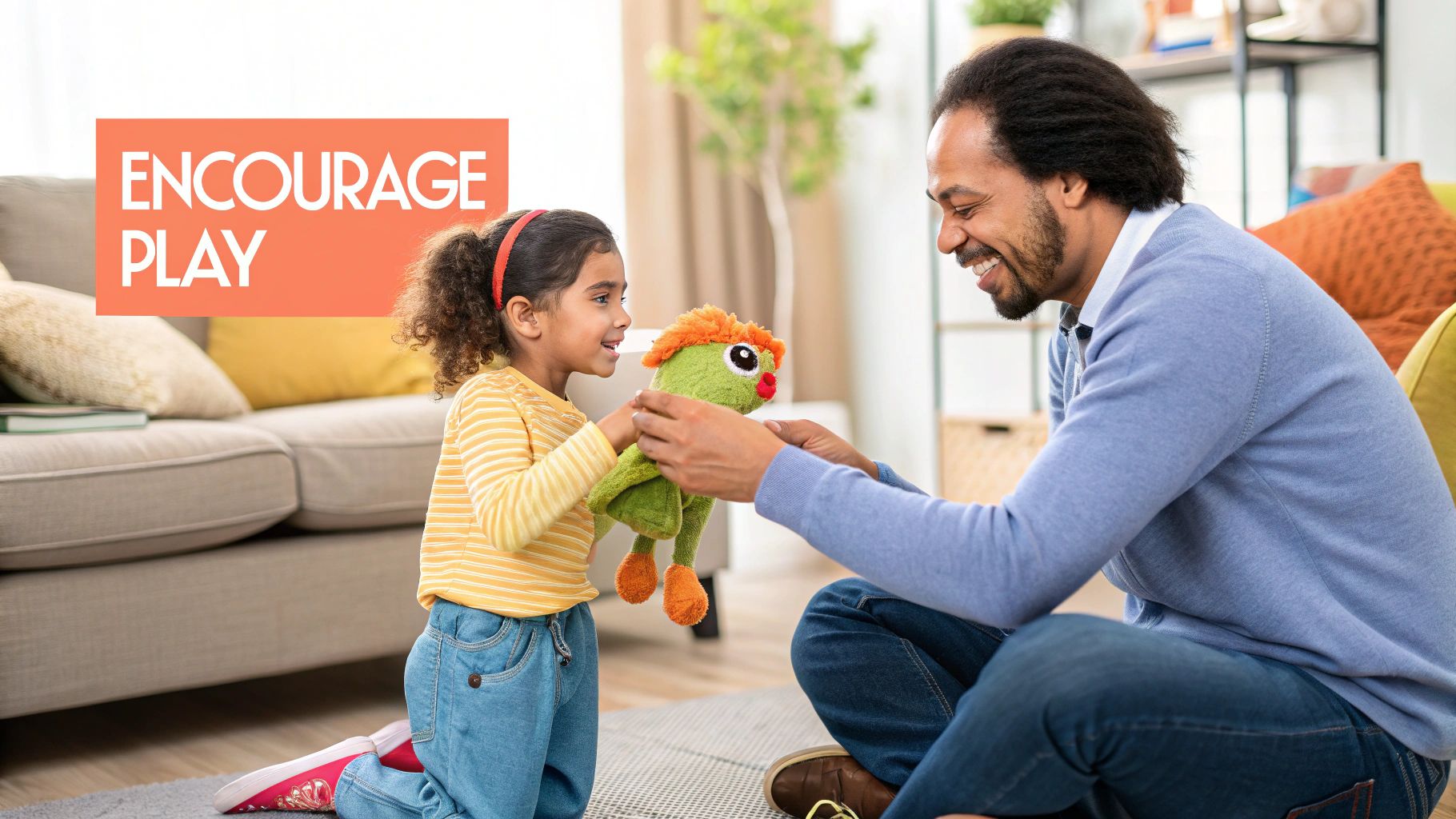
You already know there's a special kind of magic in your child’s pretend worlds. But how do you keep that creative fire burning with content you can actually trust? This is where the right tool can make all the difference, turning a few minutes of screen time into genuine, skill-building time.
This is exactly why we created Lunesia. Our interactive stories are a playground for the mind, where kids don’t just sit back and listen—they become the hero of their own adventure.
From Listener to Leader
Picture this: your child is faced with a choice. How can they help a nervous little dragon find its courage before a big flight? Or what’s the kindest way to share a magical discovery with a friend in an enchanted forest? In a Lunesia story, they get to make that call, and their decision shapes where the story goes next.
These aren't just whimsical tales; they're practice sessions for real-life virtues, carefully woven into the fun. Every choice is a chance to rehearse:
- Kindness: By making compassionate decisions for the characters they meet.
- Problem-Solving: By thinking through dilemmas to move the story forward.
- Resilience: By guiding characters through tough spots and seeing them succeed.
This hands-on approach is what makes the lessons stick. Instead of just being told to be kind, children experience the positive impact of their choice firsthand, locking in that value in a way they’ll never forget.
A Safe Harbor for Growing Minds
As a parent, your child’s safety is everything. We get it. That’s why Lunesia is a completely secure, 100% ad-free environment. There are no sneaky pop-ups, no external links, and zero distracting content—just pure, imaginative storytelling.
While your child is safely immersed in an adventure that nurtures their emotional intelligence, you get that priceless, guilt-free moment for yourself. You can finally take a breath, knowing they aren’t just being entertained; they are in a space designed to help them grow into a kinder, braver person.
It’s the ultimate win-win.
Common Questions About Imaginative Play
Feeling more sure-footed about imaginative play? That’s fantastic! Still, it’s completely normal to have a few questions lingering. Let’s walk through some of the most common ones I hear from parents all the time.
Common Questions
Here's a quick look at some frequent queries about imaginative play.
| Question | Answer |
|---|---|
| At what age does imaginative play start? | You'll see the first sparks around 18-24 months, when toddlers pretend a banana is a phone. It blossoms into complex story-driven play between ages 3 and 7. |
| Is it okay if my child has an imaginary friend? | Absolutely! It’s a healthy sign of a creative, developing mind. Imaginary friends let kids explore relationships and practice social skills in a safe space. |
| How can I encourage play without buying more toys? | The best toys often aren't toys at all! Cardboard boxes, old blankets, and scarves are perfect fuel for creativity. Ask open-ended questions to invite them to create. |
| What if my child prefers playing alone? | Solo imaginative play is perfectly normal and important. It's where they can process thoughts and emotions without outside influence, building independence and self-reliance. |
| My child gets bored of pretend play quickly. What can I do? | Try introducing a simple prop or a story prompt. Sometimes all they need is a small spark to get their engine running. Guided stories, like those in Lunesia, can kickstart an adventure. |
Let's dive a little deeper into some of those.
At What Age Does Imaginative Play Start?
Curious when the magic really begins? You'll typically spot the first glimmers of imaginative play emerging around 18-24 months old. This is when toddlers start using objects symbolically—like picking up a banana and pretending it’s a telephone.
That simple act blossoms into much more complex, story-driven play between the ages of 3 and 7, where they're not just using props but building entire worlds.
Is It Okay If My Child Has an Imaginary Friend?
Absolutely! Is there an invisible friend dining at your table every night? That’s actually a wonderful sign of a creative, developing mind.
Imaginary friends are incredible tools. They allow children to explore relationships, practice social skills, and work through big feelings in a completely safe, judgment-free context. So pull up an extra chair—it's a good thing!
How Can I Encourage Play Without Buying More Toys?
It’s a common misconception that more toys equal more play. In my experience, the opposite is often true. The best "toys" are often not toys at all.
You can easily fuel incredible imaginative play by providing simple, open-ended materials you already have lying around the house.
- Provide the Props: A cardboard box isn't just a box; it's a rocket ship, a castle, or a secret cave. Old blankets, scarves, and pillows are the perfect building blocks for creativity.
- Ask Open-Ended Questions: Instead of directing their play, invite them to create. Try asking, "What could we build with these pillows?" or "I wonder where this magic carpet could take us?"
For an extra spark, guided stories like those in Lunesia can kickstart an entire afternoon of play. They provide a narrative to build on long after the story itself has finished.
Ready to turn screen time into meaningful, imaginative adventures? Discover how Lunesia helps your child become the hero of their own story, building kindness and courage one choice at a time. Start your free trial today at lunesia.app.
